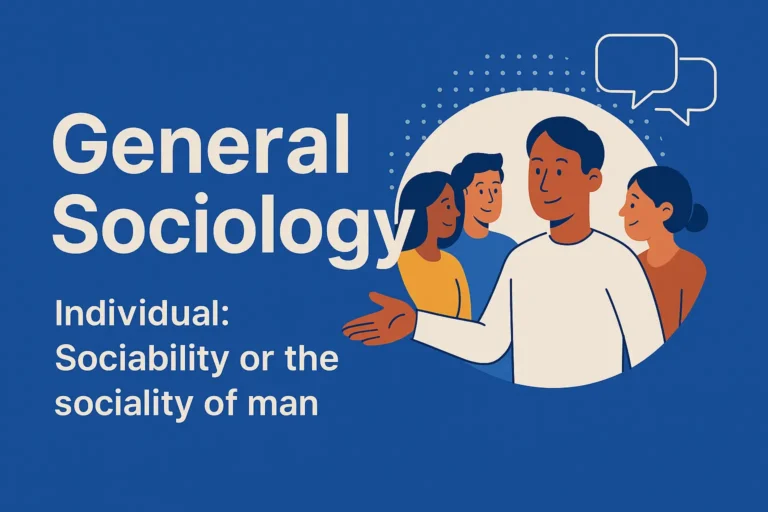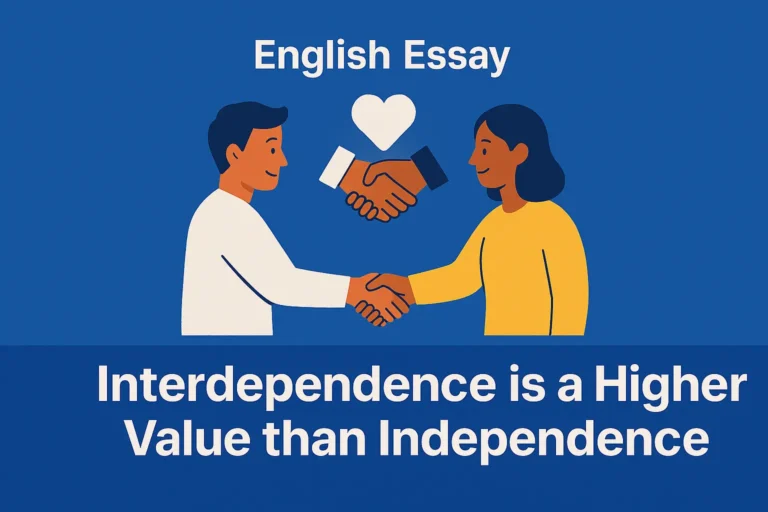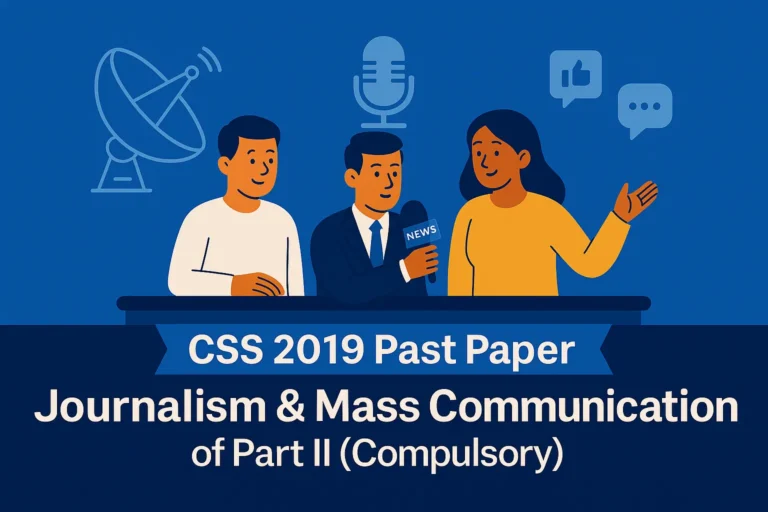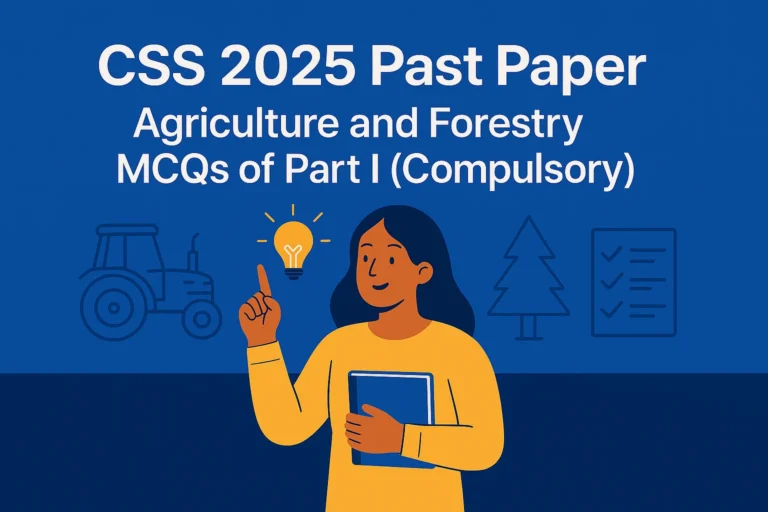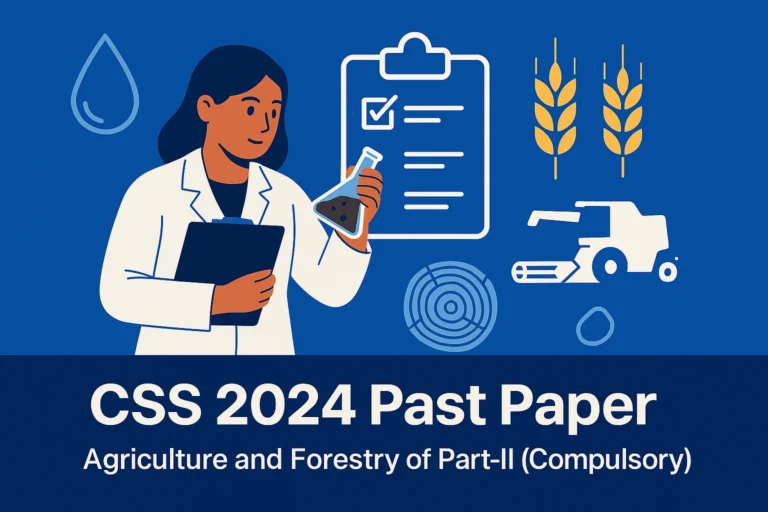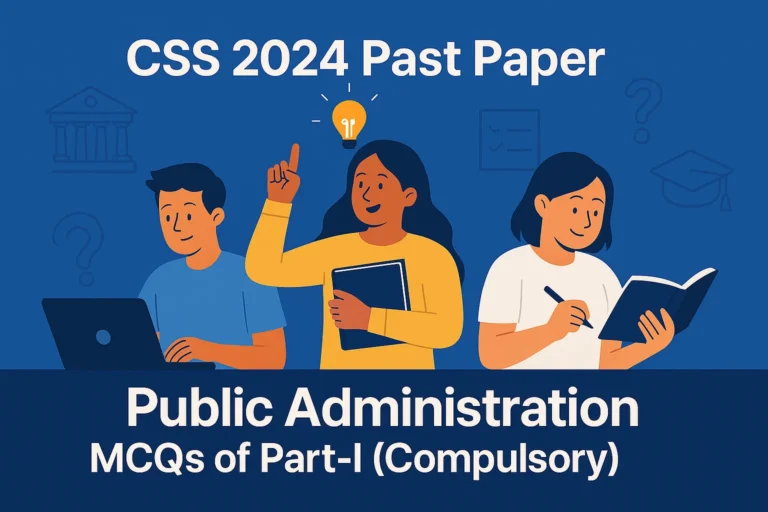CSS 2016 Solved Past Paper – Journalism & Mass Communication Part-II (Compulsory)
Below is the solution to PART-II (COMPULSORY) of the CSS 2016 Journalism & Mass Communication Paper.
Question 2
Media effects can be analyzed in term of “Powerful Effects”, “Limited Effects” and “Moderate Effects”. Which effects model is applicable in Pakistan; explain with the examples from Pakistani media and society quoting relevant theories.
Introduction
Media plays a very important role in shaping the opinions, behaviors, and beliefs of people. Different researchers have studied how much influence media has on audience, and from that, three main models came out – Powerful Effects, Limited Effects, and Moderate Effects. These models explain how strongly media affects society.
Powerful Effects Model
This model came in early 20th century. It says that media has direct, strong and immediate effect on people. One popular theory under this model is Magic Bullet Theory (also called Hypodermic Needle Theory). According to this theory, media injects messages into audience like a needle, and people accept it without question.
Example from Pakistan:
In 2007, when Lal Masjid Operation happened, media showed strong and emotional coverage. Many people were influenced by that without checking facts. It shows how media messages can have strong impact if people are not critical.
Limited Effects Model
This model came later, and it says that media has weak and indirect influence. People are not passive, they have their own opinion, knowledge, and social groups that affect how they take media messages. The Two-Step Flow Theory is part of this model. It says people get media messages through opinion leaders, not directly.
Example from Pakistan:
During elections, many people follow political discussions in their family or community more than news channels. So, if one influential person supports a party, others may follow, even if the media is saying something else.
Moderate Effects Model
This is more modern and balanced model. It says media has some effect, but not always powerful or always weak. It depends on many things like message type, audience background, time, and context. The Agenda-Setting Theory fits here. It says media may not tell people what to think, but it tells them what to think about.
Example from Pakistan:
Pakistani news channels give long coverage to political dramas, court cases, and breaking news. Because of this, people start discussing those issues more, even if those are not the biggest problems. This shows that media sets the public agenda.
Which Model Applies to Pakistan?
In Pakistan, Moderate Effects Model seems most accurate. Our media is free but sometimes irresponsible. People are not fully educated in media literacy, but they are not completely passive either. So, media does influence society, but that influence is not always direct or total.
Sometimes, media creates panic by showing breaking news again and again (like during bomb blasts), which is powerful effect. But in other times, people don’t believe everything (like when media is seen biased). This shows that media effects in Pakistan are situational, which fits with moderate model.
Conclusion
Pakistan’s media environment is complex. Sometimes, it acts like powerful effects model, especially when emotional or sensational content is shown. Other times, people filter media through their own beliefs, like in limited effects. But overall, the moderate effects model is best to explain media’s role in Pakistani society. Media has influence, but not full control. Theories like Agenda Setting and Two-Step Flow help us understand how media actually works here.
Question 3
What is functional approach? Discuss in detail the ideal role of mass media in a democratic setup. Formulate a workable solution to overcome media’s sensationalism toward political issues of Pakistan.
What is Functional Approach?
Functional approach is a way to study how media serves the society. It means looking at functions media performs for people and for the system. The idea comes from functionalism in sociology, where everything in a society has a purpose. The same way, media has some basic roles or functions in our daily life and in the system of democracy.
According to Harold Lasswell, media performs three major functions:
- Surveillance of the Environment – Giving news and alerting people about dangers or opportunities.
- Correlation of Parts of Society – Explaining the news, giving context, and helping people understand what it means.
- Transmission of Culture – Sharing values, traditions, and culture from one generation to another.
Later, Charles Wright added a 4th function:
- Entertainment – Media also entertains people to reduce stress and give relaxation.
Ideal Role of Mass Media in a Democratic Setup
In a democracy, media is often called the fourth pillar of the state, because it checks the other powers. An ideal media in a democracy should:
- Provide accurate and fair news so that citizens can make informed decisions.
- Hold the government accountable by reporting corruption, mismanagement, or injustice.
- Give equal space to all political voices and public opinions.
- Educate people about their rights, laws, and civic duties.
- Promote national unity and avoid hate speech or division.
- Encourage dialogue between public and leadership through debates, talk shows, and editorials.
Example from Pakistan:
When media covered Panama Papers case in 2016-17, it helped people understand a complicated issue and pushed the government to take action. This is a good example of media acting in democratic spirit.
Media Sensationalism in Political Issues of Pakistan
Sadly, in Pakistan, many news channels are more focused on sensationalism than journalism. They use:
- Breaking news culture, even on small things.
- Loud talk shows with shouting and personal attacks.
- Bias toward certain political parties.
- Less research and more opinions.
This damages public trust and also creates confusion and emotional reactions among viewers. People get divided and hate grows.
Example:
During elections, many channels openly support one party and spread propaganda against others, which is not ethical.
Workable Solutions to Control Sensationalism
To fix this problem, we need strong steps:
- Media Code of Ethics: PEMRA and journalist bodies must make sure all channels follow ethical reporting. No fake news or personal attacks should be allowed.
- Media Literacy: Public should be educated to think critically. Schools and colleges must teach students how to understand news and separate facts from drama.
- Independent Editorial Boards: Newsrooms should have boards that decide what is newsworthy, not just what gives high ratings.
- Punishment for Violations: Channels spreading false news or hate speech should be fined or banned for some time.
- Promote Public Interest Journalism: News channels should be rewarded or recognized when they do investigative and public-focused journalism.
Conclusion
Functional approach helps us understand the important roles media must play in a society. In a democratic system like Pakistan, media has a big responsibility. But sensationalism is damaging its role. To make media truly serve democracy, both media owners and the government must work together to control unethical practices. Only then, media can inform, educate, and unite the nation properly.
Question 4
Explain the phenomena of globalization of media industry and its role in bringing western culture to East. Also suggest ways to avoid cultural imperialism.
What is Globalization of Media?
Globalization of media means that media content like news, entertainment, and advertisements is no longer limited to one country. It moves across borders very easily. Today, people from all around the world can watch the same movies, listen to same music, and follow the same celebrities — thanks to internet, satellite TV, and social media.
Media giants like CNN, BBC, Netflix, Hollywood, and YouTube are spreading content worldwide. This makes the world feel more connected, but at the same time, it also spreads Western values and lifestyle to other cultures, especially in the East.
How Western Culture Reaches the East through Media?
Western countries, especially the USA, produce most of the media content that is watched globally. When people in Eastern countries like Pakistan, India, or Bangladesh watch this content regularly, they slowly start adopting the Western way of living, thinking, and behaving.
Some examples of this:
- Language: Many young people prefer English over local languages.
- Fashion: Western-style clothes and fashion are becoming popular.
- Family structure: Joint family system is breaking down; individualism is rising.
- Values: Ideas like freedom, dating, and independence are shown as modern and ideal, while traditional values are seen as backward.
Even in Pakistani media, you can see the change. Many dramas and shows copy Western styles and promote liberal ideas that don’t always match our culture or religion.
What is Cultural Imperialism?
Cultural imperialism means when one powerful culture dominates and slowly replaces the local culture of another country. It’s not done by force, but through media, entertainment, and advertising.
In globalization, Western countries are not just sharing their culture, but also influencing and sometimes changing the culture of developing countries. That’s why some people say that globalization is just another name for Westernization.
How to Avoid Cultural Imperialism?
It’s not possible to stop globalization, but we can protect our own culture by taking some smart steps:
- Promote Local Media Content:
TV channels should make more dramas, movies, and cartoons that show our own values, traditions, and history. - Support Regional Languages:
Government and media houses should support local languages like Punjabi, Pashto, Sindhi, Balochi, etc., along with Urdu. - Media Policies by Government:
PEMRA and other authorities should check how much foreign content is allowed on TV. Local content should be given more airtime. - Cultural Education:
Schools and colleges should teach students about their own culture, literature, poetry, and heroes, so they feel proud of their identity. - Use of Digital Platforms:
We should make good quality Pakistani content for YouTube, Netflix, and other online platforms to show our side of the story to the world.
Conclusion
Globalization of media is a strong force. It has both good and bad sides. It helps in communication and learning, but at the same time, it can hurt the identity of local cultures. For countries like Pakistan, the challenge is to benefit from global media while protecting cultural roots. With smart policies and active efforts, we can avoid cultural imperialism and keep our culture alive.
Question 5
Social media has brought new interaction and organizing pattern; discuss in detail the use of social media as a reinforcement tool for voters by political parties. Suggest ways to counter propaganda, abusive language and sectarianism on social media
Introduction
In today’s digital world, social media like Facebook, Twitter (now X), Instagram, TikTok, and YouTube have become very powerful tools. Political parties now use social media to connect with voters, spread their messages, and influence public opinion. It has totally changed how elections and political campaigns are run in Pakistan and around the world.
How Social Media Reinforces Voter Behavior?
Political parties use social media not just to inform people, but also to shape their beliefs and keep them loyal. This is called reinforcement – it means convincing people to keep supporting a party they already like.
Some common ways this happens:
- Targeted Campaigns: Using ads to reach specific groups like youth, women, or urban voters.
- Emotional Content: Posting videos, slogans, and stories that connect with voters emotionally.
- Direct Communication: Leaders post directly to their followers without using traditional media. Example: Imran Khan’s direct video messages on Facebook or X.
- Hashtag Trends: Creating popular hashtags to control the online debate and show strength.
- Volunteer Groups: Forming online teams to comment, share, and defend the party 24/7.
- Memes & Short Clips: Funny or emotional content helps spread political ideas fast.
Examples from Pakistan
- PTI is well known for using social media to build its youth base. Their hashtags and video clips go viral often.
- PML-N also started using Twitter and YouTube channels for counter-narrative.
- PPP and smaller parties are now using TikTok to reach rural areas and young audiences.
These platforms help in mobilizing voters, especially during elections or political movements.
Dangers: Propaganda, Abusive Language & Sectarianism
Along with benefits, social media is also being misused:
- Propaganda – False news is spread to damage opponents. Many fake pages post edited videos or fake news to manipulate minds.
- Abusive Language – Political workers often use abusive and harsh words for rival parties or even journalists and judges.
- Sectarian Content – Some pages spread hate between different sects or ethnic groups, which creates division and violence in society.
These problems create polarization, hate, and sometimes even real-world violence.
How to Counter These Issues?
To make social media more healthy and positive, we need strong and practical solutions:
- Cyber Laws Enforcement
PECA (Prevention of Electronic Crimes Act) must be used properly to punish those who spread hate, lies, or abuse online. - Reporting & Fact-Checking
Social media users should learn how to report fake or harmful content. Fact-checking websites must be promoted. - Digital Literacy Programs
Schools and colleges should teach students how to use social media responsibly, check facts, and avoid getting emotional over fake posts. - Code of Conduct for Political Parties
Election Commission and Parliament should make a code that stops political parties from using abusive content or hiring online trolls. - Religious Harmony Campaigns
Media and scholars should work together to stop sectarianism and promote unity through peaceful messages online.
Conclusion
Social media is a double-edged sword. On one side, it is a strong tool for political engagement, but on the other side, it is also being used to spread hate and lies. In Pakistan, political parties are using it well to reach voters, but they must also act responsibly. If we want a peaceful and informed society, we need better laws, awareness, and unity on digital platforms.
Question 6
Private Television Channels have gained commendable importance in our society. Cut through competition for rating has been observed. In view of that describe its social role (in term of pro-social role and anti-social role).
Introduction
After the media liberalization in Pakistan during early 2000s, many private TV channels came into existence like Geo, ARY, Dunya, Express, Samaa, etc. These channels have now become a big part of our daily life. From news to entertainment, they influence how people think, behave, and react.
With the race for TRPs (ratings), channels are trying to attract more viewers — but sometimes this creates problems. Their role can be seen in two ways: pro-social (positive) and anti-social (negative).
Pro-Social Roles of Private TV Channels
These are the positive contributions that private media makes to society:
- Awareness & Information
TV channels give people news, weather updates, health tips, and public service messages. During elections or disasters, they help spread important info fast. - Education
Some channels and programs teach about social issues like child abuse, women rights, environment, and more. Programs like “Bolta Pakistan” or “Zara Hat Kay” create critical thinking. - Promoting Democracy
Media gives voice to different political parties and also holds leaders accountable by exposing corruption and mismanagement. - Cultural Promotion
Entertainment shows and dramas also show our traditions, music, and values. Some good serials promote family unity and social ethics. - Job Creation
Private media industry provides jobs to thousands of people like journalists, anchors, cameramen, writers, actors, etc. - Disaster Coverage
During floods, earthquakes, and COVID-19, media played a vital role in informing people and helping government reach out.
Anti-Social Roles of Private TV Channels
Unfortunately, due to competition for ratings, many channels cross ethical lines. This leads to negative impact on society.
- Sensationalism
Minor stories are presented as breaking news. Channels over-hype everything just to grab attention, which creates panic and confusion. - False Information
Sometimes, in the race to be “first,” channels don’t verify news properly. Fake or incomplete information spreads fast and harms public opinion. - Political Bias
Some channels support certain political parties openly. This creates polarization and makes people fight on political lines even in families. - Lack of Ethics
Coverage of private issues like showing victims’ faces or using violent images is common. There’s no proper respect for media ethics. - Promotion of Violence and Crime
Some dramas and talk shows promote guns, violence, or fraud as if it’s normal. Young people may copy such behaviors. - Neglecting Real Issues
Instead of focusing on poverty, education, inflation, and health, channels focus more on political fights, celebrities, and scandals.
Conclusion
Private TV channels in Pakistan have become very powerful in shaping the society. They have done many good things by informing and educating the public, but due to the race for ratings, they also do harm by spreading fear, hate, and division.
There is a need for strong media laws, ethical training for journalists, and a sense of responsibility by channel owners. Only then, private TV can become a true positive force in our society.
Question 7
Why Public Relations Officers are called Spin Doctors? Discuss the role and responsibilities of Press Information Department (PID); also critically evaluate its performance as an institution in image building of Federal Govt.
Why Public Relations Officers are Called Spin Doctors?
The term “Spin Doctor” is used for Public Relations (PR) officers or media advisors who try to control how information is presented in the media, especially in politics.
They are called spin doctors because they:
- “Spin” the facts to make them look better.
- Use clever language, selective truth, or emotional appeal to influence public opinion.
- Try to change the focus from negative news to positive ones.
In simple words, a spin doctor doesn’t lie directly, but presents facts in a way that protects the image of their boss or organization.
Example:
If a minister is caught in a scandal, the PR officer may highlight his past achievements or blame media for misunderstanding, instead of directly denying the incident.
This is why PR officers are often seen as people who “massage the truth” to build a good image.
Role and Responsibilities of Press Information Department (PID)
The Press Information Department (PID) is the main media wing of the Federal Government of Pakistan. It works under the Ministry of Information and Broadcasting.
Key Roles of PID:
- Official Communication
It releases official press statements, government achievements, decisions, and policies to the media. - Media Monitoring
PID watches newspapers, news channels, and digital media to check how government is being portrayed. It prepares media summaries for ministers. - Public Relations
It manages the image of government by organizing press conferences, briefings, and interviews of ministers and officials. - Press Accreditation
It gives press cards to journalists for official events and access. - Ad Distribution
It controls distribution of government advertisements to newspapers. This gives it influence over media outlets. - Crisis Management
In times of national issues or disasters, PID handles the information flow and ensures unity in the government message.
Critical Evaluation of PID’s Performance in Image Building
While PID has a big role, its performance is often criticized.
Weaknesses and Criticism:
- Old-fashioned Methods
PID still uses outdated communication tools. It is not very active on digital or social media, which is now more powerful than print or TV. - Political Bias
Sometimes PID works more like a propaganda tool for ruling party instead of giving fair and balanced information. - Lack of Transparency
The ad distribution system is not fully transparent. Ads are often used to reward friendly media and punish critical ones. - Low Public Engagement
PID does not interact much with the public directly. In modern PR, public engagement is very important. - Slow Response
In times of crisis (like floods or terrorism), PID sometimes fails to provide fast, clear, and united messages.
Suggestions to Improve PID’s Role
- Modernize Communication Tools
PID should become more active on social media platforms and use modern PR strategies. - Hire Skilled Professionals
Trained and qualified PR professionals should be hired instead of only bureaucrats. - Transparent Ad System
Make ad distribution fair and based on performance, not political loyalty. - Two-way Communication
Start public feedback systems like live sessions, helplines, or online Q&A with officials. - Media Training for Govt Officials
Help ministers and spokespersons to communicate better with media.
Conclusion
Public Relations Officers are called Spin Doctors because they try to shape public opinion by spinning facts. In Pakistan, the Press Information Department (PID) plays a key role in managing the federal government’s image, but it needs modern reforms. If PID becomes more transparent, professional, and tech-savvy, it can be a powerful tool for positive nation building and trust between public and state.
Question 8
Briefly explain the following:
a. Defamation Act 2002
b. Role of PEMRA in current scenario
c. Importance of Shannon-Weaver model in development of further models
d. Business Communication
a. Defamation Act 2002
Introduction
The Defamation Act 2002 is a law in Pakistan that protects people from false statements that can damage their reputation. This law covers both libel (written) and slander (spoken) defamation.
Key Points
- If someone publishes or says something untrue that harms another person’s dignity, character, or social image, they can be sued under this law.
- The law applies to print media, electronic media, and even social media.
- The affected person can go to civil court and claim damages (money) as compensation.
- Under this law, the burden of proof is on the accused, who must prove that the statement was true and for public good.
- It aims to stop character assassination in politics, journalism, and social life.
Example
If a TV anchor accuses a politician of corruption without proof, the politician can file a defamation case under this act.
b. Role of PEMRA in Current Scenario
Introduction
PEMRA (Pakistan Electronic Media Regulatory Authority) was made in 2002 to regulate private TV channels, FM radio stations, and cable operators in Pakistan.
Current Role
- Issues Licenses to TV and radio channels.
- Monitors Content to make sure channels follow laws and don’t spread hate, obscenity, or fake news.
- Takes Action by issuing warnings, suspending licenses, or imposing fines on channels breaking rules.
- Tries to maintain balance between media freedom and responsibility.
- Promotes local content and protects public morals and religious values.
Criticism
PEMRA is sometimes seen as biased or influenced by government. Some say it targets certain channels or uses its power to control media freedom.
Still, in today’s media environment, PEMRA plays an important role in keeping a check on unethical practices and maintaining media standards.
c. Importance of Shannon-Weaver Model in Development of Further Models
Introduction
The Shannon-Weaver Model was developed in 1948 by Claude Shannon and Warren Weaver. It is one of the first communication models and is also called the “Mother of All Models”.
Why it’s important?
- Introduced key parts of communication: Sender, Message, Channel, Receiver, and Noise.
- Focused on how messages are transmitted, like in telephones, radio, etc.
- Helped in understanding communication as a process, not just one-time action.
- Highlighted the issue of noise (disturbance), which affects message clarity.
- Inspired future models like Berlo’s SMCR model, Schramm’s model, etc.
Even though it was made for technical communication, it helped researchers apply the same idea to human communication, mass media, and interpersonal talks.
d. Business Communication
Introduction
Business Communication means sharing information inside and outside a company to help it work better. It includes emails, reports, meetings, presentations, letters, etc.
Features
- Formal and Clear: Must use professional tone and simple language.
- Goal-Oriented: Every message should serve a purpose (like informing, requesting, or persuading).
- Two-Way Process: It includes feedback and clarification.
- Written & Verbal Forms: Can be through letters, memos, face-to-face talks, or even digital platforms.
Importance
- Helps in team coordination and decision-making.
- Builds company image when dealing with customers and clients.
- Reduces confusion and misunderstanding in office work.
- Improves efficiency, productivity, and work culture.
Example
A sales manager sending monthly sales report to the head office is doing business communication.
Conclusion
All four topics are basic but important for media and communication students. From legal protections like the Defamation Act, to regulatory bodies like PEMRA, and foundational concepts like Shannon-Weaver model and business communication, each plays a big role in journalism and professional media life.

